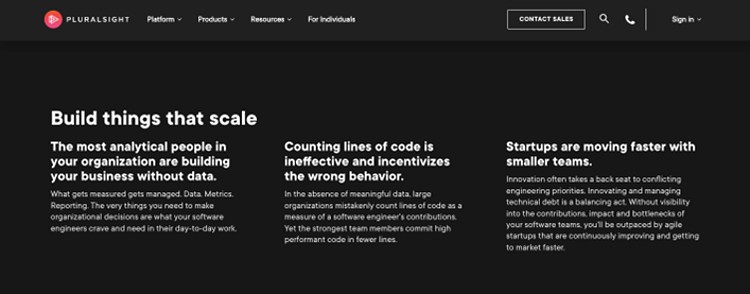When your sales cycle is complex and lengthy, you might feel anxious that your leads will pull out at any moment. After all, the B2B sales cycle lasts for more than half a year, on average. And for SaaS businesses? It takes nearly nine months for the delivery of a newborn deal.
That's a long time for your buyers to feel motivated about your service.
Now sure, you have the essentials down: Your technical features are impressive and your testimonials are glowing; and as for your marketing and sales efforts, they're addressing your customers' needs—just as they should.
But the question lingers: How you can you remain memorable during the consideration stages?
Your product might well be strong, but that's not enough to keep your brand memorable to buyers. Many SaaS companies "struggle to get inside [buyers'] consideration sets. It's because they over-index on the product and under-invest in messaging, narrative, and point of view," CXL's CEO, Peep Laja, points out.
Therein lies the key: messaging is what gets you into more consideration sets.
And to make your messaging more memorable, you'll need to start with your most important touchpoint. It's the one usually visited at multiple stages during your customer's journey: your website.
Yep, your website is the most important marketing channel buyers use when forming their consideration sets.
OK, so your buyers visit your website. You want them to choose you... but your product isn't enough. That leaves one question: How are your buyers' decisions being made?
You can get a clear answer from Harvard Business School's Gerald Zaltman: "95% of our purchase decision-making takes place in the subconscious mind."
So if you want your brand to be memorable, it's time to climb into your buyers' mind. Here are three ways you can get into more consideration sets using persuasive and memorable messages.
1. Optimize your messages to please a buyer's irrational brain
As humans, we're considered to have two decision-making brains: the lizard, unconscious brain, and the conscious, thinking brain.
It's the unconscious brain that makes quick judgments. Your buyers' attitudes toward you can be formed very quickly—often within 1/5th of a second. In those first moments, they may reject or approve you. So it's true to say that your prospect's first impressions can make or break your sale.
Problem is... your buyers will use mental shortcuts to save on brain energy. Those shortcuts aren't always rational. And your buyer's unconscious brain tends to reject anything that contradicts its irrational beliefs.
So your buyer has an irrational brain that you need to please. But how can you do that—without lying to them?
The answer: influence your buyers' cognitive biases. All while telling the truth.
For example, when you use real before-and-after stories of past clients—you're tapping into a bias known as Contrast Effect.
There's also the Status Quo Bias: We want to stick to our current habits, rather than learn new forms of behavior. So if your solution is complex, aim to delight your buyers' unconscious brains. Show how easily you fit into your buyers' current workflows. And distract them from short-term losses (like money and time) by focusing on longer-term gains, like your most attractive outcomes.
Create an easy "yes" for your buyers' unconscious decision-making brains.
2. Keep your prospects interested by controlling their attention
Your marketing and sales team are fighting a battle for your prospect's attention. With so many distractions in your buyers' life—including your competitors, who can easily lure them away—you should keep them focused.
That is, focused on your brand.
So draw your reader in with engaging and hyper-relevant messages—speak straight to your buyers' interests.
You can find a goldmine of insights into your buyers' concerns by conducting customer research—such as surveys and interviews—and reviewing transcripts from sales calls and chatbots.
For example, learn how your current users evaluated your solution during their buying processes. How did they measure the success of your software? And who or what did they compare you with?
But be careful with competitor comparisons: "If the real alternative in the mind of a customer is Excel, you can't say your product is easier to use unless it is easier to use than a spreadsheet," positioning consultant April Dunford points out.
Know who or what your real competition is—in the eyes of your buyer.
And use messaging that focuses primarily on your prospect. Keep them engaged and excited by repeatedly using the word "you." Otherwise, they may engage more half-heartedly with your messages—and forget your brand.
A scientific study found that when businesses spoke to prospects' concerns, attitudes towards those brands were more positive; but when they didn't... fewer marketing messages were actually remembered.
So keep your copy razor-focused on your prospect.
Consider this example from Flow by Pluralsight's webpage aimed at C-level execs:

The messaging helps convince executives to consider the SaaS—by focusing on their biggest concerns. You can create relevant and specific copy only if you do your research first.
3. Make it easy for buyers to understand your value
When the service you market is complex, you place more of a strain on your prospect's memory. And our short-term memories are notoriously weak. Your C-level decision-makers could struggle just to understand the descriptions of your service.
So consider how you can simplify your copy while still showing respect for your prospect's intelligence. Simplifying doesn't mean dumbing-down. Instead, aim to reduce unnecessary jargon, shorten your sentences, and actually unpack what each of your data points means.
Your website visitors are often on a fact-finding mission. They seek certain nuggets of info that can help push the sales cycle along. At the same time, your prospects likely have a cognitive-dependent job role. They don't want yet another thing to think too hard about.
So don't bury important information within long paragraphs. I can't tell you how many times I see SaaS websites make that mistake. Your web visitors are often scanners. When you make it easy for buyers to understand and grasp your value, you're more likely to persuade them.
In fact, UX study participants had better memories of a B2B tech webpage when it became more scannable (using bullets and boldface) and more objective (no buzzwords or unsupported claims). The result: "The data showed that the rewritten version of the site was 'better' for all four measures: task time (80% better), task errors (809%), memory (100%), and subjective satisfaction (37%)."
You want an easy "yes," not struggling to remember your value. And how your features work. And how they can implement your solution.
No matter how educated or successful your buyers are, they will have a limited capacity to process information. We simply can't take every bit of communication and data into the imperfect brains of ours. So we're efficient. We look for important information... but only when we can actually find it.
* * *
You might think you're targeting decision-makers. But it's more realistic to say that you're targeting the decision-makers' decision-makers—their conscious and unconscious brains. Aim to please both of those thinking models by using strategic messaging... and you could have a more confident prospect on your hands.
It might be tempting to overestimate your product's importance. And yet, as Peep Laja asserts, it's "almost impossible to win [deals] by having an objectively better product. But most anyone can win on brand (the sum of your story, messaging, positioning, marketing), especially against the category leaders."
What an optimistic idea: When you optimize your messaging, you could win more business—even over rivals with bigger budgets.
More Resources on Brand Messaging
How People Want Brand Messaging to Make them Feel
Three Steps to Amplify Your Brand Message Beyond the Walls of Your Event
Four Ways to Keep Your Brand and Marketing Relevant Amid Fluctuating Cultural Trends




